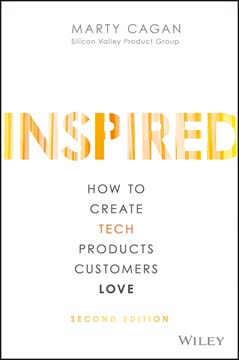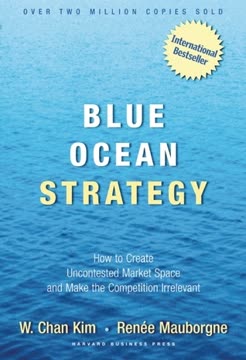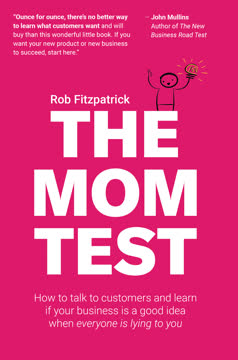Key Takeaways
1. Good strategy is unexpected and leverages coherent action
A good strategy has an essential logical structure that I call the kernel. The kernel of a strategy contains three elements: a diagnosis, a guiding policy, and coherent action.
Diagnosis is key. Good strategy begins with a clear-eyed assessment of the challenge at hand. This diagnosis simplifies complex realities by identifying critical aspects of the situation. The guiding policy then outlines an overall approach to overcome the obstacles identified in the diagnosis. Finally, coherent action involves coordinated steps designed to support the guiding policy.
Unexpected power. Effective strategies often gain advantage because rivals don't anticipate them. This element of surprise comes from insightful diagnosis and creative problem-solving, not just from secrecy. Good strategies coordinate policies and actions in ways that create a competitive punch or powerful problem-solving effect.
Examples of good strategy:
- Hannibal's victory at Cannae: Anticipated Roman behavior and designed coordinated actions
- Walmart's retail strategy: Integrated network of stores, distribution centers, and information systems
- Apple's turnaround under Steve Jobs: Simplified product line and focused on design and user experience
2. Bad strategy masks the absence of clear goals with fluffy language
Bad strategy follows the crowd, substituting popular slogans for insights.
Hallmarks of bad strategy:
- Fluff: Excessive use of buzzwords and jargon to hide lack of substance
- Failure to face the challenge: Avoiding the hard work of identifying and analyzing obstacles
- Mistaking goals for strategy: Stating desires without a plan to overcome difficulties
- Bad strategic objectives: Impractical or incoherent goals that fail to address critical issues
Common causes of bad strategy:
- Unwillingness to make tough choices
- Reliance on template-style strategy formulation
- Overemphasis on "vision" without concrete plans
- New Thought-style positive thinking that ignores real-world obstacles
Bad strategy often arises from organizational inertia, political compromises, or leaders' desire to please everyone. It can also stem from a misunderstanding of what strategy actually is, confusing it with goal-setting or financial forecasts.
3. Sources of power in strategy: leverage, proximate objectives, and design
To achieve leverage, the strategist must have insight into a pivot point that will magnify the effects of focused energy and resources.
Leverage involves identifying and exploiting pivot points where concentrated effort can produce outsized results. This requires deep understanding of the situation and creative problem-solving to find unexpected advantages.
Proximate objectives are goals that are close enough at hand to be feasible. They provide clear direction and help coordinate problem-solving efforts. Good proximate objectives break down larger challenges into manageable steps.
Design in strategy involves creating a cohesive configuration of resources and actions that yields advantage. Like designing a high-performance machine, good strategic design coordinates multiple elements to work together efficiently.
Key elements of strategic design:
- Mutual adjustment of parts
- Focus on critical interactions
- Balance between integration and flexibility
- Adaptation to competitive context
4. Effective strategies exploit waves of change and industry transitions
To generate a strategy, one must put aside the comfort and security of pure deduction and launch into the murkier waters of induction, analogy, judgment, and insight.
Riding waves of change. Successful strategies often capitalize on broader trends and transitions in technology, markets, or regulations. This requires leaders to develop a keen sense for emerging patterns and the ability to anticipate second-order effects.
Identifying inflection points. Strategic opportunities often arise during periods of significant industry change. These inflection points can upset existing competitive positions and enable new strategies.
Examples of strategic exploitation of change:
- Cisco Systems' rise in networking equipment
- Apple's transformation of the music industry with iTunes and iPod
- Amazon's pioneering of e-commerce and cloud computing
Attractor states. Understanding the long-term equilibrium state an industry is moving towards can provide valuable strategic insight. This concept helps leaders distinguish between temporary fluctuations and fundamental shifts in industry structure.
5. Inertia and entropy are major obstacles to strategic change
Even with change programs running at full throttle, it can take many years to alter a large company's basic functioning.
Types of organizational inertia:
- Inertia of routine: Entrenched processes and habits resist change
- Cultural inertia: Deeply held beliefs and values impede adaptation
- Inertia by proxy: Stakeholders' resistance to change affects the organization
Entropy in organizations refers to the tendency for order and focus to degrade over time without active maintenance. This requires leaders to constantly work on reinforcing purpose, structure, and methods.
Overcoming inertia and entropy:
- Simplification: Strip away unnecessary complexity
- Fragmentation: Break political coalitions and expose inefficiencies
- Triage: Identify units to close, repair, or use as nuclei for new structures
- Challenge: Set ambitious goals to build new habits and routines
Leaders must recognize that changing large organizations is an intensely strategic challenge requiring diagnosis, guiding policy, and coherent action.
6. Scientific thinking is crucial for developing and testing strategies
A strategy is, like a scientific hypothesis, an educated prediction of how the world works.
Strategy as hypothesis. Good strategies, like scientific theories, are testable predictions about what will work in a given situation. They should be based on careful observation and analysis, but also involve creative insight.
Empirical approach. Effective strategists, like good scientists, pay close attention to real-world results and are willing to revise their theories based on new evidence. This requires:
- Careful observation of outcomes
- Willingness to acknowledge and learn from failures
- Continual refinement of strategic hypotheses
Importance of anomalies. Unexpected results or contradictions to prevailing wisdom often point to important strategic insights. Leaders should cultivate the ability to spot and investigate anomalies.
Proprietary information. Like scientific experiments, business operations generate valuable data. Strategists should design their organizations to capture and learn from this proprietary information.
7. Independent judgment is vital in strategy, especially during market bubbles
Being strategic is being less myopic—less shortsighted—than others.
Overcoming cognitive limitations. Good strategists develop techniques to counteract natural human biases and limitations in thinking. This includes:
- Making lists to overcome forgetfulness and force prioritization
- Using mental models and frameworks to structure complex problems
- Cultivating a "panel of experts" to critique ideas
Dangers of social herding. During market bubbles or periods of excessive optimism, it's crucial for leaders to maintain independent judgment. This requires:
- Understanding fundamental industry economics
- Recognizing patterns from historical examples
- Resisting the temptation to follow the crowd
Inside view vs. outside view. Strategists must balance the detailed knowledge of their specific situation (inside view) with broader patterns and statistics (outside view). Overreliance on the inside view can lead to overconfidence and failure to learn from relevant examples.
Practicing judgment. Good strategic thinking is a skill that can be developed through practice. Leaders should:
- Commit judgments to writing before discussions
- Evaluate the accuracy of past predictions
- Continuously refine their ability to assess situations and make decisions
Last updated:
FAQ
What's Good Strategy Bad Strategy about?
- Core Concept: The book distinguishes between good and bad strategies, emphasizing that good strategy involves coherent action and a clear diagnosis of challenges.
- The Kernel of Strategy: Richard P. Rumelt introduces "the kernel," consisting of a diagnosis, a guiding policy, and coherent actions, as the foundation of effective strategy.
- Real-World Examples: It includes case studies from various industries, such as Apple and the U.S. military, to illustrate successful and unsuccessful strategies.
Why should I read Good Strategy Bad Strategy?
- Practical Insights: The book offers actionable insights for leaders and managers on developing effective strategies, cutting through common business jargon.
- Identifying Bad Strategy: Rumelt helps readers recognize bad strategy hallmarks, such as "fluff" and mistaking goals for strategy, to prevent costly mistakes.
- Framework for Success: By learning the kernel of good strategy, readers can enhance their strategic decision-making capabilities in their organizations.
What are the key takeaways of Good Strategy Bad Strategy?
- Importance of Diagnosis: A good strategy starts with a clear diagnosis of the challenges faced by an organization, identifying critical issues.
- Guiding Policy and Coherent Actions: The guiding policy outlines an approach to overcoming obstacles, while coherent actions are specific steps to implement this policy.
- Focus on Leverage: Effective strategies leverage resources and actions to maximize impact, concentrating efforts on pivotal objectives.
What is the "kernel" of good strategy as defined in Good Strategy Bad Strategy?
- Three Essential Elements: The kernel consists of a diagnosis, a guiding policy, and coherent actions, each playing a crucial role in forming a comprehensive strategy.
- Diagnosis: This identifies critical challenges and simplifies the complexity of the situation, allowing leaders to focus on what truly matters.
- Guiding Policy and Coherent Actions: The guiding policy provides a framework for addressing challenges, while coherent actions are specific steps to implement the policy effectively.
How does Rumelt define "bad strategy" in Good Strategy Bad Strategy?
- Four Hallmarks of Bad Strategy: Rumelt identifies fluff, failure to face the challenge, mistaking goals for strategy, and bad strategic objectives as key indicators.
- Fluff: Vague language and high-sounding goals that lack substance, creating an illusion of strategic thinking without addressing real issues.
- Failure to Face Challenges: Bad strategy often avoids defining actual challenges, leading to a lack of focus and direction.
What are some examples of good strategy from Good Strategy Bad Strategy?
- Apple's Turnaround: Steve Jobs' return to Apple is highlighted as a case of good strategy, focusing on core offerings and simplifying the product line.
- Desert Storm: General Norman Schwarzkopf's strategy during the Gulf War is presented as an example of effective military strategy with a two-pronged approach.
- Wal-Mart's Success: Rumelt discusses Wal-Mart's strategy of serving smaller towns with low prices and efficient logistics, creating a competitive advantage.
What are the best quotes from Good Strategy Bad Strategy and what do they mean?
- "A good strategy honestly acknowledges the challenges being faced and provides an approach to overcoming them.": Emphasizes recognizing real challenges rather than glossing over them with vague goals.
- "Bad strategy is not simply the absence of good strategy.": Highlights that bad strategy has its own logic, often stemming from misconceptions about strategy.
- "The essence of strategy is a clear and differentiated point of view that supports forceful and coherent action.": Encapsulates the idea that effective strategy requires clarity and decisiveness in action.
How can I identify bad strategy in my organization using Good Strategy Bad Strategy?
- Look for Fluff: Check for vague language and high-level goals that lack actionable steps, indicating bad strategy.
- Assess the Diagnosis: Ensure the strategy includes a clear diagnosis of challenges faced; undefined challenges may lead to ineffective strategy.
- Evaluate Coherence: Analyze whether proposed actions are coherent and aligned with the guiding policy; disjointed actions indicate a lack of focus.
What role does anticipation play in good strategy according to Good Strategy Bad Strategy?
- Predicting Behavior: Anticipation involves understanding and predicting competitors' behavior and market trends, positioning organizations advantageously.
- Creating Leverage: By anticipating future developments, organizations can leverage resources and actions to maximize impact, leading to competitive advantages.
- Example of Anticipation: Toyota's investment in hybrid technology is cited as effective anticipation, foreseeing demand for fuel-efficient vehicles.
How does Good Strategy Bad Strategy suggest organizations can create focus?
- Identify Pivotal Objectives: Concentrate on a few critical objectives that can yield significant results, channeling resources effectively.
- Avoid Spreading Resources Thin: Rumelt warns against pursuing multiple goals simultaneously, as this dilutes efforts and reduces success likelihood.
- Use Proximate Objectives: Setting proximate objectives allows for actionable steps achievable in the near term, maintaining momentum and focus.
What is the significance of coherent actions in Good Strategy Bad Strategy?
- Alignment with Guiding Policy: Coherent actions must align with the guiding policy, ensuring all efforts are directed toward the same objectives.
- Building Momentum: Coherent actions create direction and purpose, fostering a culture of accountability and progress within the organization.
- Example of Coherence: Starbucks' coordinated actions to enhance customer experience and brand loyalty illustrate coherence contributing to success.
What techniques does Rumelt recommend for improving strategic thinking?
- Create-Destroy Method: Involves generating new alternatives while critically evaluating existing ones, uncovering better strategies.
- Use of Virtual Experts: Creating a mental panel of experts to critique and refine strategic ideas helps gain diverse perspectives and challenge assumptions.
- Commit to Judgments: Writing down judgments and recommendations enhances accountability and facilitates learning, encouraging reflection and improvement.
Review Summary
Good Strategy Bad Strategy offers a clear framework for developing effective strategies, distinguishing between good and bad approaches. Rumelt emphasizes the importance of diagnosis, guiding policy, and coherent action in crafting successful strategies. The book provides numerous real-world examples and case studies, illustrating both effective and ineffective strategies across various industries. Readers appreciate Rumelt's straightforward style and practical insights, though some find certain examples lengthy. Overall, it's considered a valuable resource for leaders, business owners, and decision-makers seeking to improve their strategic thinking and implementation.
Similar Books










Download PDF
Download EPUB
.epub digital book format is ideal for reading ebooks on phones, tablets, and e-readers.





